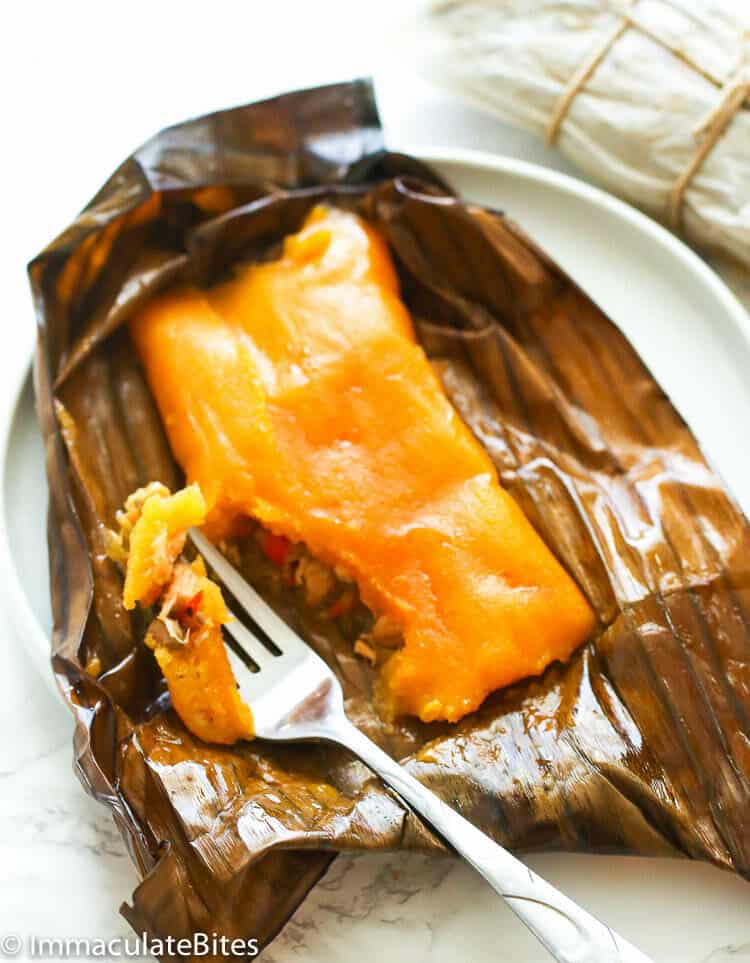steles are a tender, savory, and complex Puerto Rican delicacy. Delicious masa filled with a savory meat stew cooked and then steamed in banana leaves is an ideal treat for the holidays or any time. Their versatility is impressive.
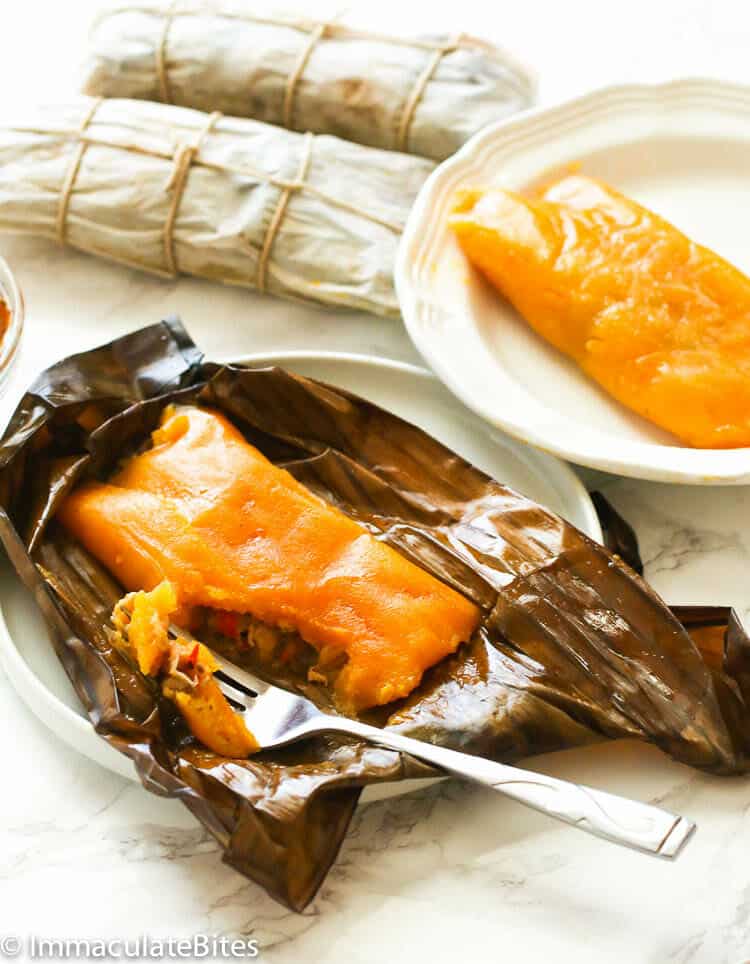
A Puerto Rican friend of mine loves these so much she has them shipped overnight from Puerto Rico. I had to know why. So when I finally got the opportunity to try them, I understood.
My first bite of the slightly sticky goodness filled with savory pork was mindblowing. Everyone told me they’re hard and time-consuming to make. But I did not care. Yes, they take time, but they are not hard.
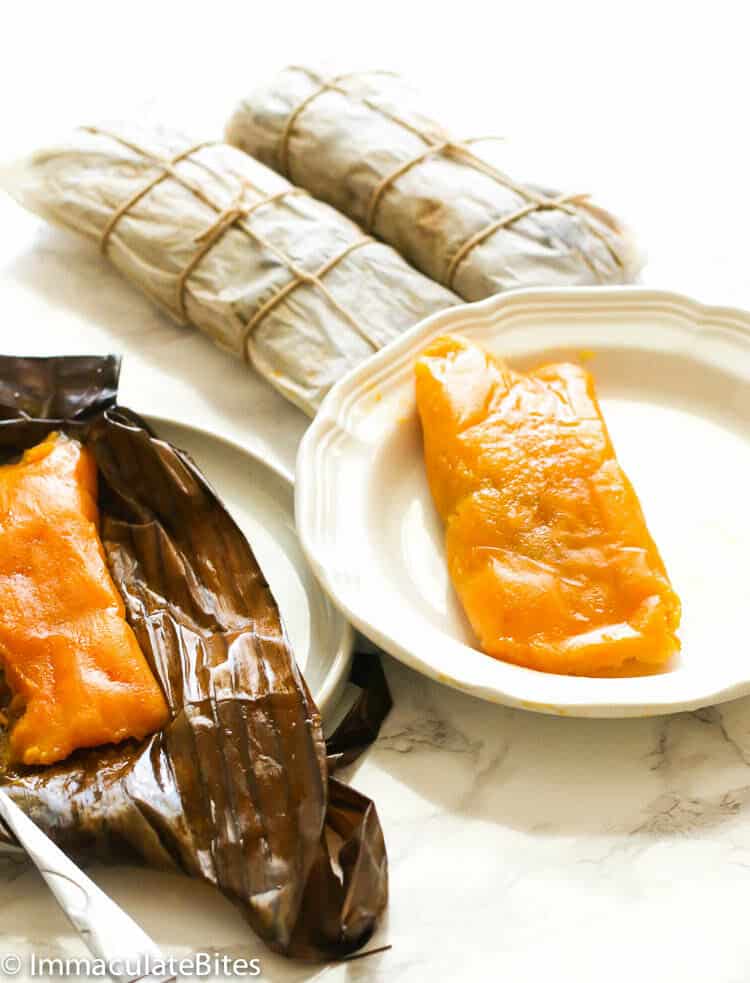
What Are Puerto Rican Pasteles?
A labor of love! That’s how I describe pasteles from Puerto Rico (pastel for singular). It’s the perfect slow food when you want to enjoy time with the family. And the time it takes time is definitely worth it.
Pasteles are a traditional Latin American Christmas dish, especially in Puerto Rico. But families also enjoy them in the Dominican Republic, Colombia, Panama, Trinidad, and Tobago. It’s more than just food; it’s about the stories, laughter, and togetherness while making this labor-of-love treat!
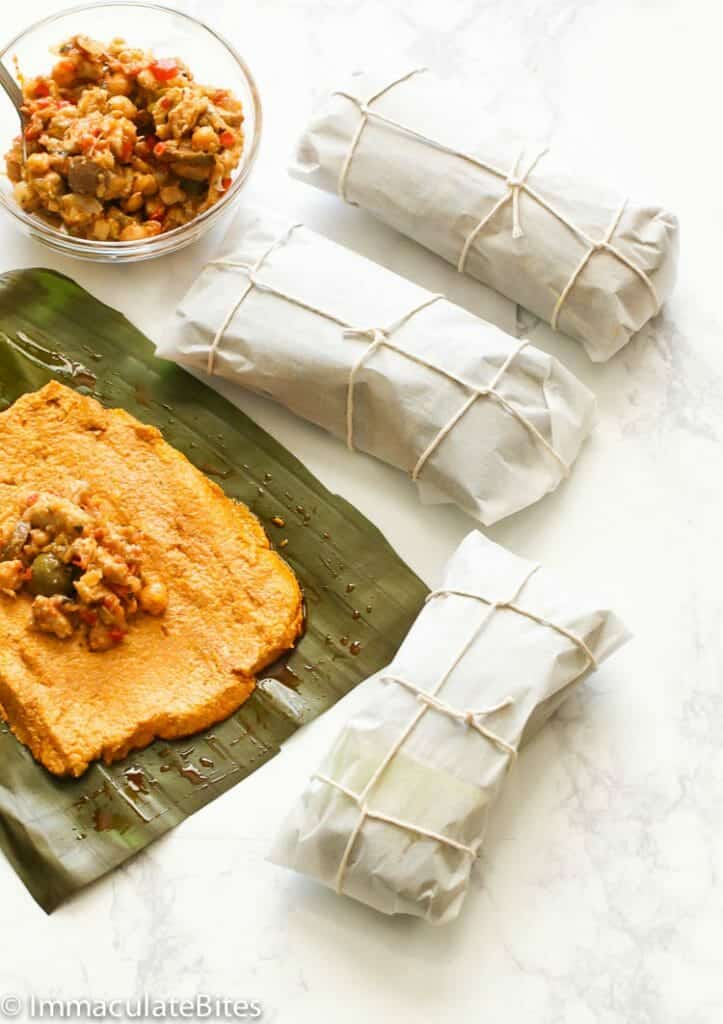
Recipe Ingredients
Filling
- Pork – The shoulder provides the best meat for pasteles, but you can use what you have available.
- Seasonings – Garlic, Puerto Rican sofrito, onion, oregano, red bell pepper, jalapenos, Sazon sin achiote (annatto), tomato sauce, salt, and pepper deliver incredible flavor.
- Chickpeas – An optional ingredient that ups the protein.
- Broth – Just enough liquid to keep it moist and add flavor.
Yuca Masa
- Cassava – Also called yuca, it gives the pasteles substance and is slightly sticky when cooked so everything stays together.
- Seasonings – Garlic, onion powder, salt, Sazon with achiote, and achiote oil add flavor and a gorgeous yellow color.
Traditional Masa
- Masa Base – This incredibly versatile recipe uses green bananas, green plantain, yautia (cocoyams or taro root), potato, and pumpkin or squash. Mix and match what you have, add seasonings, and you’re good to go.
How to Make Puerto Rican Pasteles
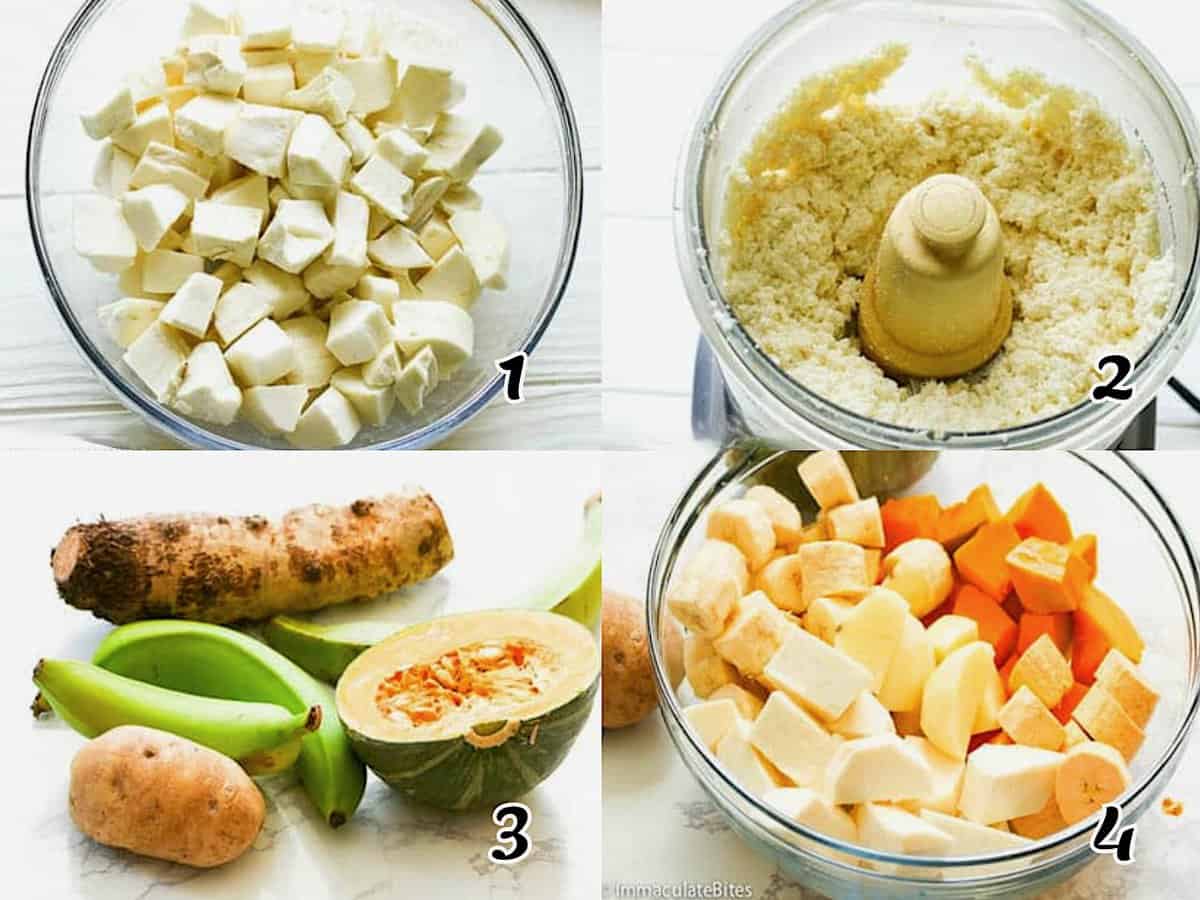
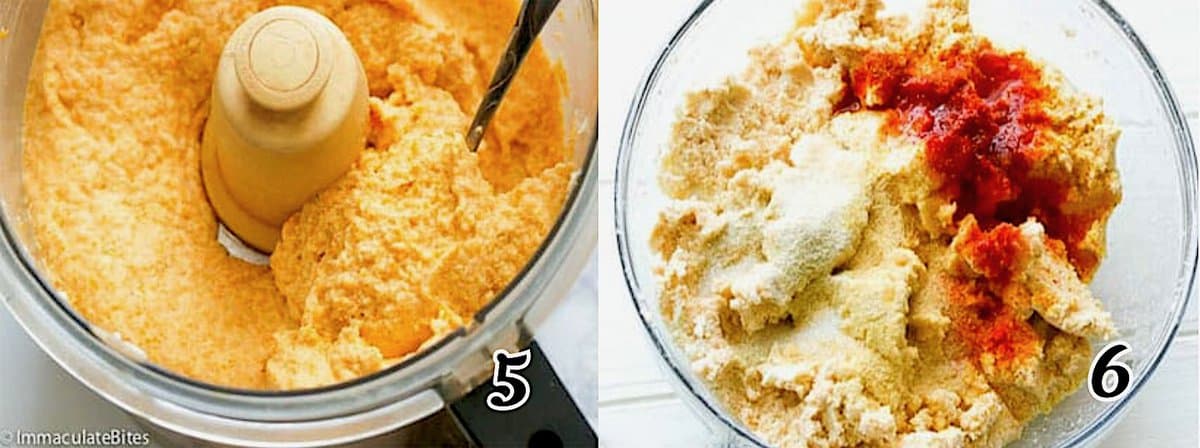
Masa
- Prep Yuca – Cut off both ends of cassava/yuca and then cut them in half. Make a shallow cut into the skin of the cassava and gradually work your knife under the skin to remove it. Split in half, then remove the inner woody core in the center and discard it. Cut into small chunks and rinse immediately to prevent discoloration; leave them in cool water until ready to use. (Photos 1-2)
- Or Prep the Other Masa – Peel the bananas, plantains, taro root, potatoes, cocoyams, and pumpkin if making the traditional masa. Cut in small pieces and proceed with the rest of the instructions. (Photos 3-4)
- Puree – Pulse the cassava (yuca) or the traditional ingredients in a food processor until pureed, or grate them. You may have to do so in batches. (Photo 5)
- Season – Pour it into a large bowl, then add garlic and onion powder, salt, Sazon, and oil. Mix thoroughly and set aside. (Photos 6-7)
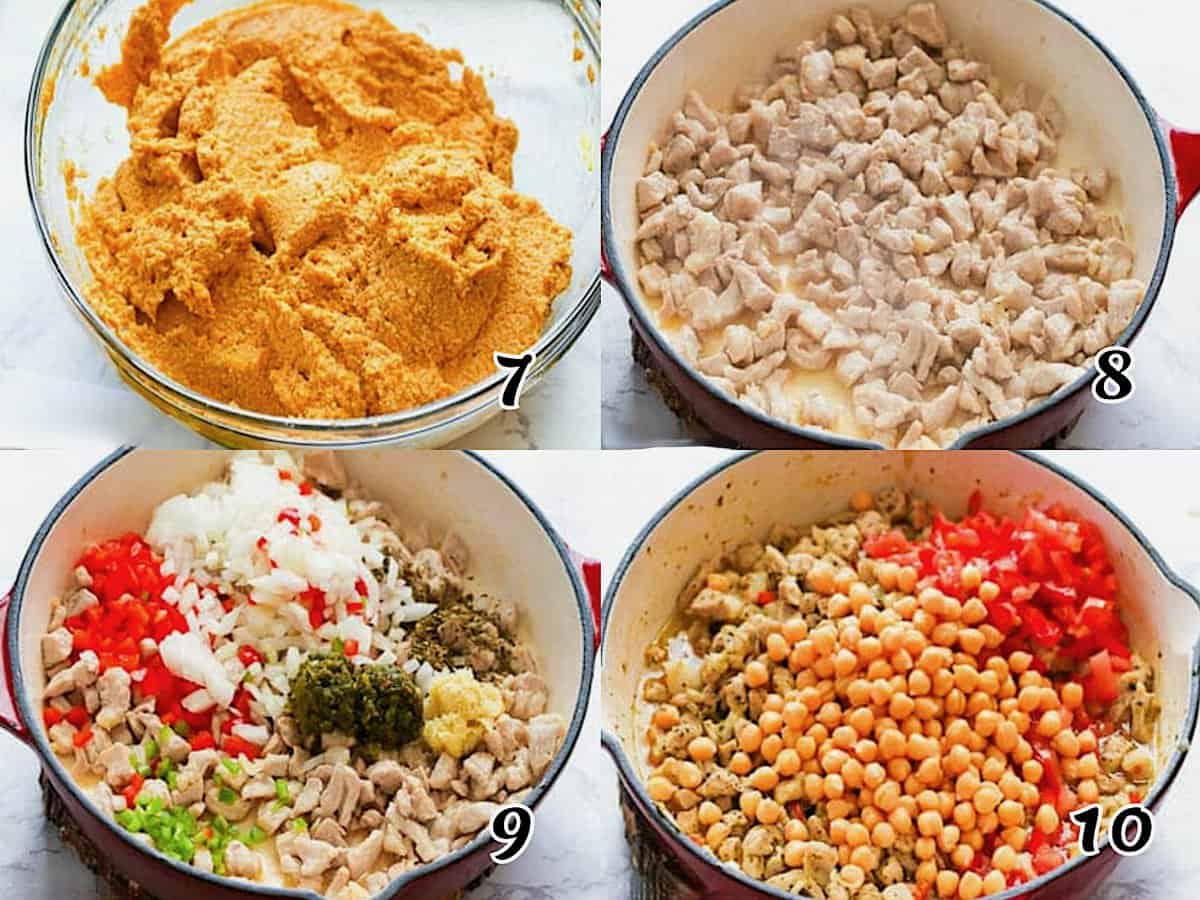
Pork Filling
- Pork – Heat a large skillet over medium. As soon as it’s hot, add 2-3 tablespoons of oil and the diced pork, and cook until slightly brown or the pork is no longer pink. It may take 6-7 minutes. (Photo 8)
- Season – Add sofrito, garlic, onions, and oregano to the skillet, and cook for 3-5 minutes or until onions wilt. (Photo 9)
- Simmer – Throw in tomatoes, bell peppers, jalapenos, and chickpeas (if using). Then add about ¾ cup broth or water. Simmer uncovered until the liquid reduces and the sauce just coats the pork (about 15 minutes). (Photo 10)
- Adjust seasoning with salt, pepper, and other desired spices, and let cool slightly. Adjust seasonings spices, if needed. Set aside.
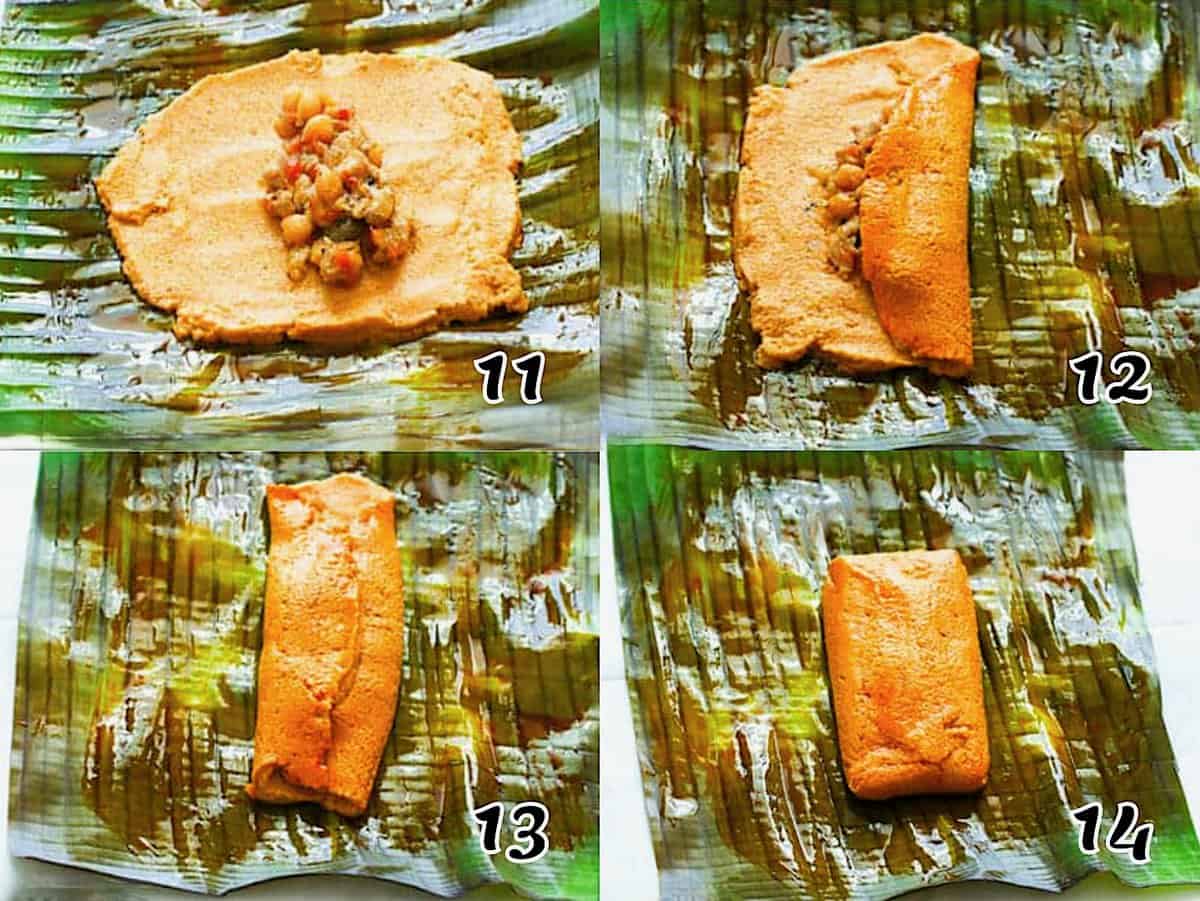
Assembly
- Prep Banana Leaves – Prepare a work surface to assemble and wrap the pasteles. A board or countertop works fine for this process. If using freshly picked banana or plantain leaves, cut off the central rib, trim the edges, and cut into the desired sizes. To make them flexible for folding, wilt them in single layers or slightly overlapping in a 200℉ (90℃) oven for 5-10 minutes.
Note: An alternative method of wilting is to place the leaves directly over the coils of an electric range on low heat or pass them carefully over the low flame of a gas range. Be careful not to burn them excessively. Wipe with a damp kitchen cloth or paper towel. - Trim – Cut the banana leaves into rectangles or squares, cutting off the central rib if visible. Then, trim off the edges. The next step is to submerge them in water to clean, drain, and pat dry. They’re now ready to use.
- Arrange Banana Leaves – To start the wrapping, place parchment paper on your work surface and top with a banana leaf square. Then brush it with achiote oil. Add about two tablespoons of masa and spread masa to form a small square, just like in the pictures. (Photo 11)
- Wrap – Add a spoonful of pork filling to the masa. Pick up the edge of the pastel closest to you and fold it over the filling until it meets the other edge. Make sure it touches the other side so the pastel stays fully enclosed. Fold the bottom edge of the square up and over so that the masa encloses the pork filling. (Photos 12-15)
- Tie it with kitchen string so it doesn’t come apart. Repeat to form the remaining pasteles. (Photo 16)
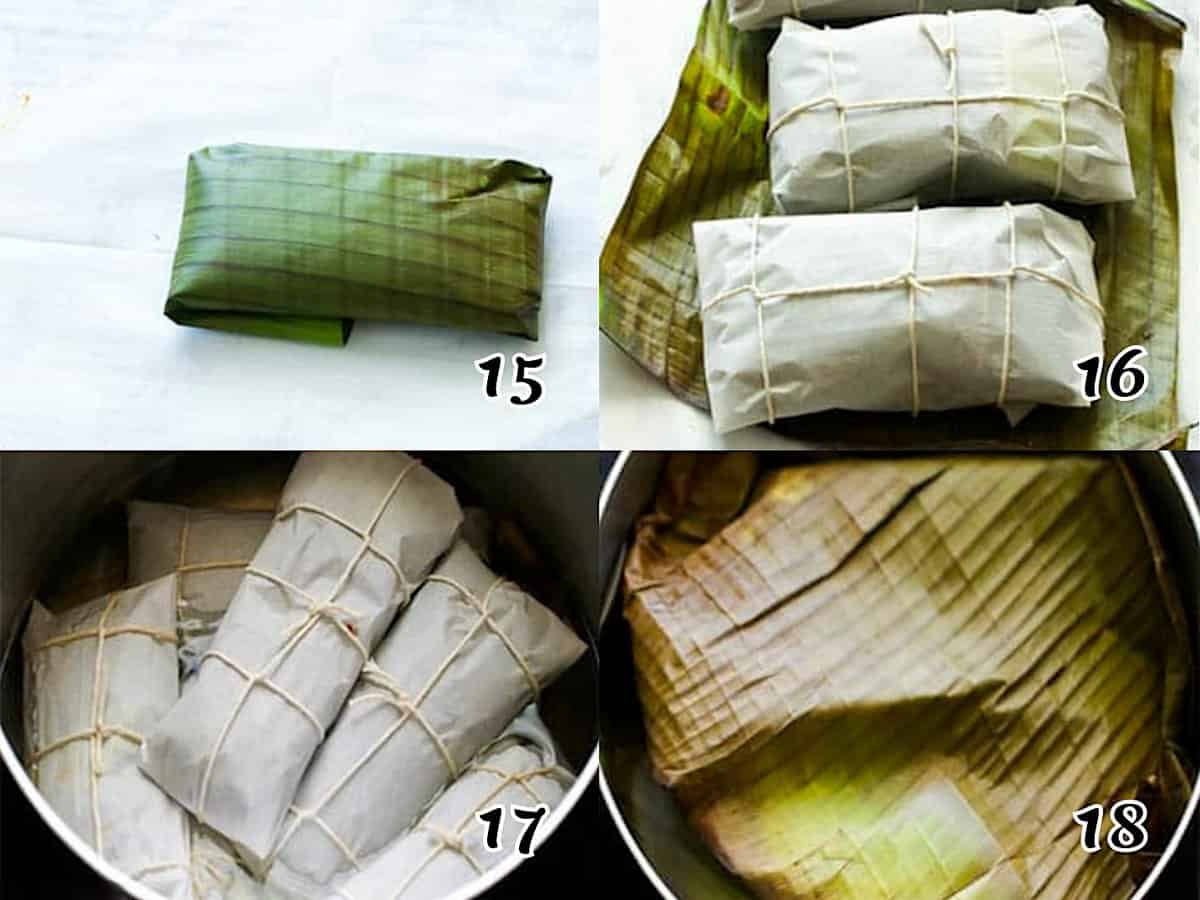
Cook
- Steam – Line a large steamer or pot with a layer of banana leaf scraps. Add a cup or more of water and bring to a boil. Next, place the pasteles in two loose layers, adding as much hot water as needed to almost submerge them. Cover with any remaining banana leaves. (Photos 17-18)
- Final Stretch – Let the pasteles steam for an hour or more, adding water as needed. You don’t want the water to dry up and burn the banana leaves. Test one to ensure they’re fully cooked. Turn the heat off and let them sit in the pot for about 20 minutes to cool down.
- Serve – Carefully remove the pasteles with tongs if they’re too hot because you don’t want to get burned. Transfer them to a platter, remove the strings, and carefully open them. Please be careful; they can release hot steam as you open them. Serve warm.
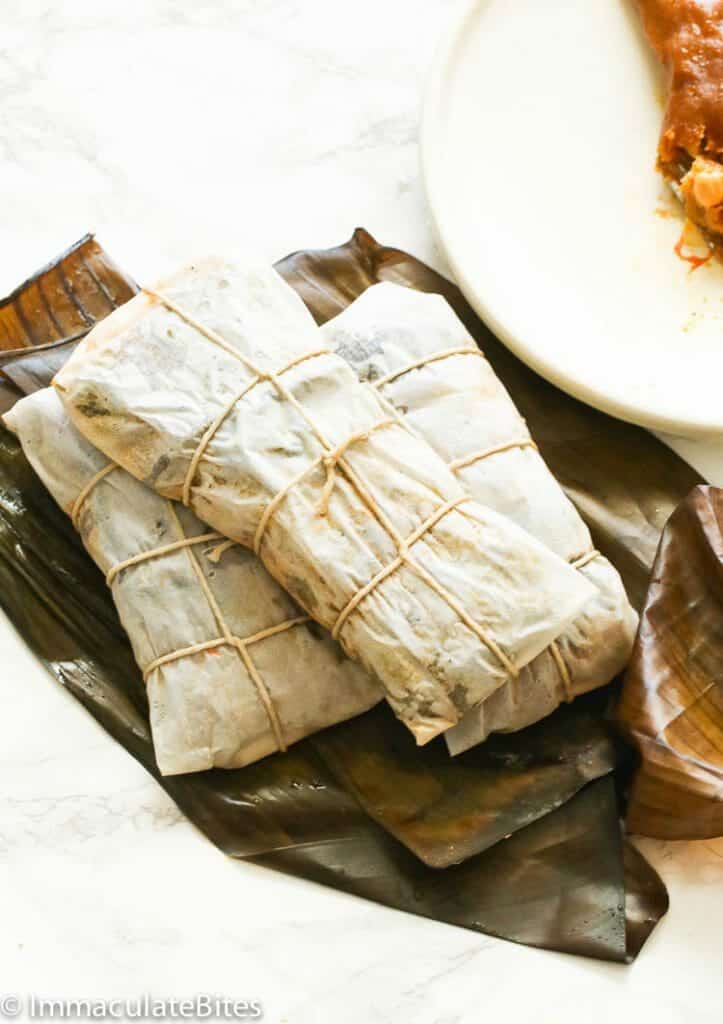
Recipe Variations
- Meat Swap – Replace the pork with chicken, beef, lamb, chorizo, etc. Any of them make a great pastel.
- Vegetarian – Replace the meat with garbanzo beans and potatoes for a vegan version. No one will miss the meat.😉
- Masa – Yuca, green bananas, green plantains, squash, taro (malanga or yautía), and true yams mix and match for incredible pasteles. Some countries even use rice.
- Casserole – If you don’t have banana leaves or don’t feel like tying the pasteles, make a casserole. Grease a square baking dish, add half of the masa, layer with the filling, and top it with the other half of the masa. A little grated cheese with the filling isn’t bad, either. 😍 Bake at 350℉ (175℃) until done (about an hour).
- Tamales – Use masa harina or other corn filling and wrap them in corn husks for a Mexican twist.
Tips and Tricks
- Make this a family affair for easy assembly. If you’re looking for a slow food experience, this is it.
- You can usually find frozen banana leaves in Latin markets. It does impart a unique taste to the already delicious pasteles.

Make-Ahead and Storage Instructions
These guys are labor-intensive, so it’s a good thing you can freeze them for 2-3 months. When ready to enjoy them, prepare the steamer per instructions and steam them as usual.
Because they’re frozen, they’ll take longer to cook (maybe twice as long?). Just break one open and see if it’s done about an hour in. You can also refrigerate them for 2-3 days.
What to Serve With Puerto Rican Pasteles
A classic Christmas dinner in Puerto Rico includes pasteles, roasted pork, arroz con gandules, and coquito. A side of escabeche (pickled vegetables) and Puerto Rican pique (peri peri is close) is always a plus.
More Savory Puerto Rican Recipes to Try
Watch How to Make It
[adthrive-in-post-video-player video-id=”CGXUP2dD” upload-date=”2020-11-22T06:00:00.000Z” name=”Pasteles” description=”Pasteles – a traditional Puerto Rican Christmas dish that is tender, savory and complex in flavors. It’s made of ground starchy case filled with a delicious savory meat stew, wrapped in banana leaves and boiled to cook through. A delicious treat to unwrap during the holidays!” player-type=”collapse” override-embed=”false”]This blog post was originally published in October 2018 and has been updated with additional tips, new photos, and a video.
Puerto Rican Pasteles
Prep: 2 hours
Cook: 1 hour
Total: 3 hours
Puerto Rican
Instructions
Masa (Dough)
-
Cut both ends of the cassava (yuca) off and cut them in half.
-
Make a shallow cut into the skin and gradually work your knife under it to remove the skin. Split it in half lengthwise, remove the woody core, and discard it.
-
Cut into small chunks and rinse immediately to prevent discoloration, and leave them in cool water until ready to use.
-
If making traditional masa, peel the bananas, plantains, taro root, potatoes, cocoyams, and pumpkin.
-
Cut in small pieces and proceed with the rest of the instructions.
-
Pulse the cassava (yuca) in a food processor until pureed, or grate it. You may have to do so in batches.
-
Pour it out in a large bowl, then add the garlic powder, onion, salt, oil, and Sazon, thoroughly mix, and set aside.
Pork Filling
-
Heat a large skillet over medium. As soon as it’s hot, add 2-3 tablespoons of oil, add the diced pork, and cook until slightly brown or the pork is no longer pink (it may take 6-7 minutes).
-
Add sofrito, garlic, onions, and oregano to the skillet, and cook for 3-5 minutes or until onions wilt.
-
Throw in tomatoes and chickpeas, if using any. Then add about ¾ cup broth or water.
-
Simmer uncovered until the liquid reduces and just coats the pork, about 15 minutes or more.
-
Season the pork filling to taste with salt and let cool slightly. Adjust seasonings spices, if needed. Set aside.
Assembling Pasteles
-
Prepare a work surface to assemble and wrap the pasteles. You may use a board or countertop for this process.
-
If using freshly picked banana or plantain leaves, cut off the central rib and trim off the edges. Cut into the desired sizes. To make them flexible for folding, wilt them in single layers or slightly overlap them in a 200℉ (93℃) oven for 5-10 minutes. An alternative method of wilting is to place the leaves directly over the coils of an electric range on low heat or pass them carefully over the low flame of a gas range. Be careful not to burn them unduly. Wipe with a damp kitchen cloth or paper towel.
-
To start the wrapping, place one parchment paper on a surface and top with one piece of banana leaf. Then brush with achiote oil.
-
Add about two tablespoons of masa and spread it to form a small square, just like in the pictures.
-
Add a spoonful of pork filling to the masa.
-
Pick up the edge of the pasteles closest to you and fold it over the filling until the edge of the masa closest to you touches the other side. That helps the pasteles to stay fully enclosed. Fold the bottom edge of the square up and over so that the masa encloses the pork filling.
-
Tie the pasteles with kitchen string. Repeat to form the remaining pasteles.
-
At this point, you can freeze them for later. Place them in ziplock bags, date, label, and freeze.
Cooking Pasteles
-
Line a large steamer or pot with a layer of banana leaf scraps.
-
Add a cup or more of water – then bring to a boil. Next, place the pasteles in two loose layers. Add as much hot water as needed to almost submerge them. Cover with any remaining banana leaves.
-
Let the pasteles cook for an hour or more, adding water as needed. Please don’t let the pot dry out. Do a taste test if necessary to ensure the pasteles are fully cooked.
-
Turn the heat off and let the pasteles cool in the pot for about 20 more minutes.
-
Carefully remove pasteles with tongs, if they’re still hot because you don’t want to get burned.
-
Transfer the pasteles to a platter. Remove the strings, carefully open pasteles – it releases hot steam as you open.
-
Serve warm.
Tips & Notes:
- Make this a family affair for easy assembly. If you’re looking for a slow food experience, this is it.
- You can usually find frozen banana leaves in Latin markets. It does impart a unique taste to the already delicious pasteles.
- Please keep in mind that nutritional information is a rough estimate and can vary greatly based on the products used.
Nutrition Information:
Serving: 1pastel| Calories: 770kcal (39%)| Carbohydrates: 113g (38%)| Protein: 21g (42%)| Fat: 26g (40%)| Saturated Fat: 8g (50%)| Polyunsaturated Fat: 4g| Monounsaturated Fat: 12g| Trans Fat: 0.02g| Cholesterol: 65mg (22%)| Sodium: 349mg (15%)| Potassium: 1134mg (32%)| Fiber: 7g (29%)| Sugar: 7g (8%)| Vitamin A: 374IU (7%)| Vitamin C: 71mg (86%)| Calcium: 82mg (8%)| Iron: 2mg (11%)


